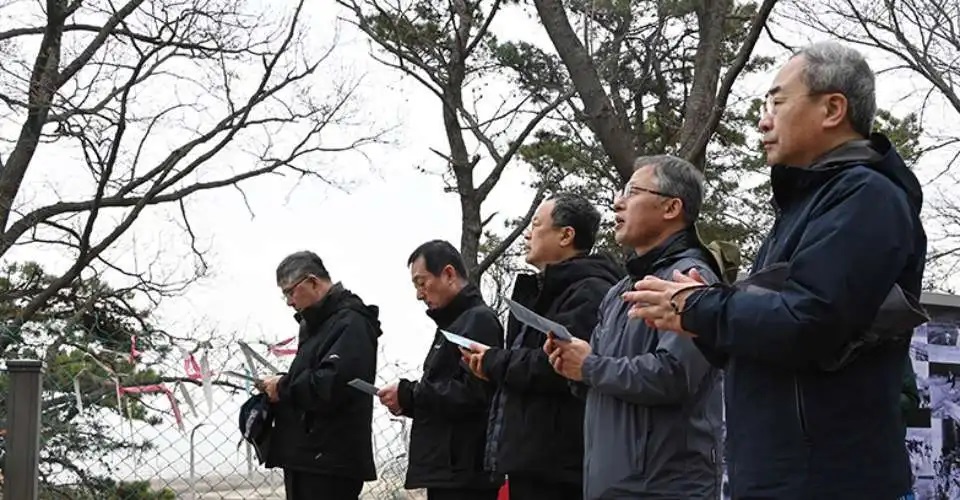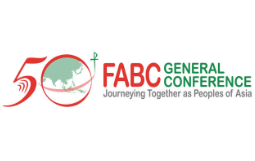Korean Bishops visit border island, pray for peace
Gyodong Island is a haven for people displaced by Korean War, just a few kilometers from communist-ruled North Korea
Apr 04, 2025

SEOUL: Five South Korean bishops have paid a visit to Gyodong Island, just across the border with North Korea, where they met North Korean refugees and prayed for peace on the Korean Peninsula.
The April 2 visit was part of the Church's renewed efforts for peace and reconciliation on the 80th anniversary of the separation of South and North Korea, according to a Catholic Bishops’ Conference of Korea (CBCK) statement released on April 3.
The bishops' delegation included Bishop Kim Ju-young of Chuncheon, Bishop Cho Kyu-man of Wonju, Bishop Jeong Jin-cheol of Incheon, Bishop Son Hee-song of Uijeongbu, and Auxiliary Bishop Moon Hee-jong of Suwon.
Four priests involved in Korean Church peace and reconciliation efforts, including Jeong Su-yong, secretary general of the bishops' conference's Committee for National Reconciliation, accompanied the bishops.
During the trip, the bishops visited the Reconciliation and Peace Center operated by the Missionary Sisters of Our Lady of the Martyrs.
The center’s director and Catholic nun, Mary Yohan Kang Min-ah, told the bishops how Gyodong Island became a haven for displaced North Koreans after the Korean War.
She said the center was founded with the hope that the island would become “a bridge for peace” and explained that the center and their convent conduct education and welfare activities among the displaced people.
The center has some residents, mostly displaced North Koreans, who can see North Korea from a close distance, she added.
At the center, the bishops met and talked to some elderly North Koreans displaced by the Korean War before heading to the nearby Gyodong Public Office to pray for peace.
The bishops walked along a coastal barbed wire fence stretching five kilometers from Gogu Reservoir toward Manghyangdae and looked out at North Korea and contemplated the reality of the division on the peninsula.
Bishop Kim Ju-young expressed his hope that “the very act of praying along the barbed wire fence and hoping for unification will disappear and the day will come soon when we can freely travel back and forth.”
The bishops ' statement said Manghyangdae was built in 1988 by those who fled from Yeonbaek, Hwanghae-do, in North Korea during the war and who long for their hometown.
It was also designated as a tourist attraction to ease the pain of separation suffered by the displaced people, instill hopes that they can once again visit their hometown and remind them of the importance of security, it added.
The bishops used telescopes to look at Yeonbaek, Hwanghae-do, just 3 kilometers from Manghyangdae, and wrote messages of hope for unification and hung them on the barbed wire fence.
The bishops then visited Daeryong Market, which was founded by displaced people selling goods brought from Hwanghae Province, and met with 93-year-old Mari An Sun-geum, a market vendor among the first generation of displaced persons on Gyodong Island.
“There were many people in the Gyo-dong area who came from the North during the Korean War, and they all miss their hometowns in the North and have lived with resentment in their hearts,” said Bishop Moon Hee-jong.
“Many of them passed away without ever being able to set foot back in their hometowns,” he lamented.
“I hope that someday peace will come to the South and the North so that we can travel back and forth,” he emphasized. “The prerequisite for that is peace.”
The bishops also met John the Baptist Choi Jong-dae, 90, who arrived on the island at 16 and now lives in Seoul. Despite his advanced age, John visits the island every week because he longs to return to his hometown in the North.
“My father and brother who came with me have passed away, and I don’t even know if the rest of my family is alive or dead,” he said. “I hope there will be peace one day, and people can visit each other.”--ucanews.com







Total Comments:0